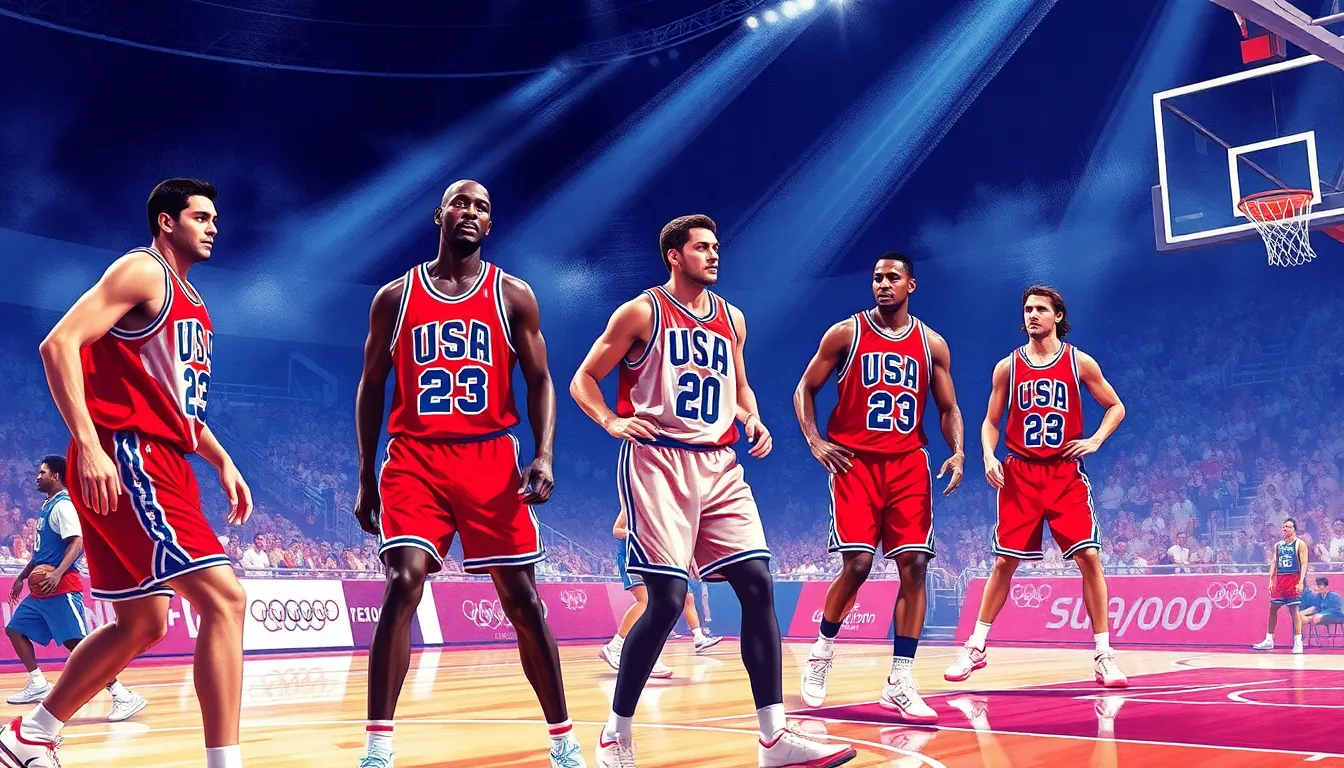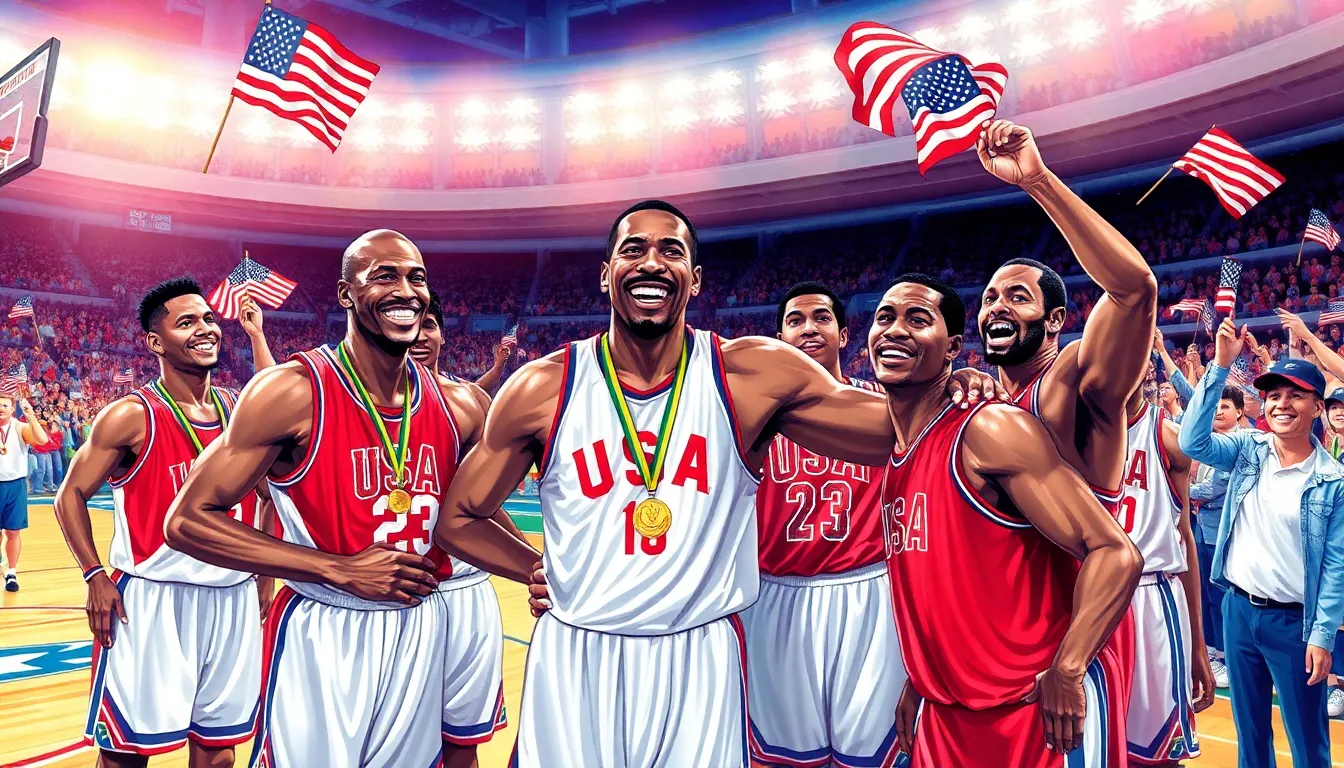In the summer of 1988, the basketball world witnessed a showdown that would forever change the game. The U.S. Olympic basketball team, a mix of college stars and seasoned pros, took to the court in Seoul, South Korea, with dreams of gold and a dash of swagger. They weren’t just playing for medals; they were on a mission to reclaim their dominance after a surprising loss in 1980.
1988 Olympic Basketball Team
The 1988 Olympic basketball team represented the United States in the Seoul Summer Olympics. It comprised college stars like Christian Laettner and experienced professionals such as Charles Barkley and Michael Jordan. The team aimed to reclaim gold after a disappointing performance in the 1980 Moscow Olympics, where they did not participate.
Coached by the renowned Bob Knight, the team’s blend of youthful talent and seasoned expertise created a formidable lineup. Key players built remarkable chemistry, which played a crucial role in their success. During the tournament, they exhibited skill, teamwork, and competitive spirit, winning matches decisively.
They faced tough competition, including strong teams from the Soviet Union and Yugoslavia. In the semifinals, the U.S. defeated the Soviet Union with a final score of 82-76, securing a spot in the gold medal game. The final match against the Soviet Union highlighted the team’s resilience and determination to win.
Ultimately, the U.S. team earned the gold medal, finishing the tournament with a solid record of 6-0. Not only did this victory restore the nation’s reputation in international basketball, but it also set the stage for the future development of the sport. The triumph in 1988 marked a significant turn in Olympic basketball, paving the way for the Dream Team in 1992.
Team Composition

The 1988 U.S. Olympic basketball team included a strategic mix of college stars and seasoned professionals, contributing to their success in Seoul.
Key Players
Christian Laettner excelled as a standout college player, bringing skill and determination to the court. Charles Barkley showcased his powerful presence, becoming a key force in both rebounds and scoring. Michael Jordan, widely regarded as one of the greatest basketball players, demonstrated remarkable leadership and talent. Other notable players included David Robinson, a dominant center known for his shot-blocking ability, and Mitch Richmond, who added versatility as a shooting guard. These athletes combined experience and athleticism, forming a cohesive unit throughout the tournament.
Coaching Staff
Bob Knight led the team, known for his intense coaching style and tactical expertise. His emphasis on discipline and teamwork built a strong foundation for the players. Assistant coaches including Mike Krzyzewski and Jim Boeheim contributed significantly, providing additional strategies and insights derived from their extensive backgrounds. This coaching staff created an environment that encouraged accountability and synergy among the players, resulting in an effective approach to each game.
Journey to the Olympics
The 1988 U.S. Olympic basketball team’s journey included crucial qualification and pre-Olympic competitions.
Qualification Process
The U.S. team qualified for the Seoul Olympics through dedicated performances in the 1987 FIBA Americas Championship. Winning the tournament provided a spot for the squad, demonstrating their resolve to reclaim lost glory after the 1980 boycott. Competing against several strong teams, the U.S. went undefeated in the championship. This qualification allowed the team to showcase its blend of college stars and seasoned professionals on an international stage.
Pre-Olympic Competitions
In preparation for the Olympics, the U.S. basketball team participated in several pre-Olympic tournaments. For instance, the 1988 McDonald’s Open in Portland featured international teams, offering valuable competition. Facing off against formidable opponents helped sharpen the squad’s skills and cohesion. Notable performances during these events built momentum, bolstering the players’ confidence. The combination of strategic training and actual competition ensured they entered the Olympics ready to compete at the highest level.
Performance in the 1988 Olympics
The U.S. Olympic basketball team demonstrated exceptional skill during the 1988 Seoul Olympics. Their journey included impressive performances in both preliminary rounds and the medal round.
Preliminary Rounds
In the preliminary rounds, the team faced various opponents, quickly establishing dominance. They achieved decisive victories against teams like the Philippines (130-50) and Spain (94-65), showcasing their talent and teamwork. Every game highlighted the players’ impressive skills, with Michael Jordan leading the charge. His scoring prowess, coupled with Charles Barkley’s rebounding efficiency, created an unstoppable combination. The team’s perfect record in this phase set the stage for the intense competition that lay ahead.
Medal Round
Entering the medal round, the U.S. team continued its strong performance. They faced the Soviet Union in the semifinals, securing an 82-76 victory, which emphasized their resilience. This win ensured their place in the gold medal match. In the finals, they met Yugoslavia, overcoming them with a final score of 117-85. The team’s effective collaboration and strategic execution were evident, earning them the coveted gold medal. Their performance not only restored national pride but also illustrated the evolution of basketball on an international scale.
Impact and Legacy
The 1988 Olympic basketball team significantly influenced the future of basketball internationally and within the United States. Their unique blend of college stars and seasoned professionals set a precedent for team composition. This strategic approach created a template for subsequent squads, particularly the 1992 Dream Team, which included a roster filled with NBA legends. The success in Seoul demonstrated the importance of chemistry and teamwork, elements that future teams prioritized.
Influence on Future Teams
Success in 1988 paved the way for evolving basketball practices. Coaches began emphasizing the importance of blending young talent with experienced players. The strategy showcased by the U.S. team highlighted the advantages of mentoring, leading to future recruitment approaches that prioritized skill and experience. Their performance during the Olympics showcased fundamental skills in teamwork and execution. Other nations took notice, adapting their training regimens and player selections to compete more effectively.
Historical Significance
Winning the gold medal in 1988 marked a critical turning point for U.S. basketball. It restored national pride following the disappointment of the 1980 boycott. Achieving victories against strong competitors showcased the resurgence of American basketball on a global stage. The tournament also heralded a shift in international competition. Rival nations began investing heavily in basketball development programs, transforming the landscape of the sport. The 1988 team solidified the United States’ position as a powerhouse in basketball, influencing how the sport evolved globally for decades to come.
Conclusion
The 1988 Olympic basketball team not only reclaimed gold but also revitalized American basketball’s standing on the world stage. Their blend of youthful talent and seasoned experience created a powerful synergy that set a new standard for future teams. The success in Seoul paved the way for the iconic 1992 Dream Team, highlighting the importance of teamwork and chemistry in achieving greatness.
This team’s legacy extends beyond medals; it inspired a generation of players and prompted other nations to enhance their basketball programs. The 1988 squad’s triumph marked a significant turning point that solidified the United States’ dominance in international basketball for years to come. Their story remains a testament to the power of perseverance and collaboration in sports.

